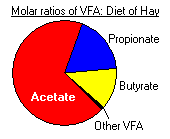VIVO Pathophysiology
Fermentation Chemistry
The forestomach of ruminants and large intestine of caudal fermenters are magnificent, continuous flow fermentation systems containing enormous numbers of microbes. What do these microbes and the process of fermentation provide the herbivore? This section will concentrate on fermentation per se, but the microbes that digest cellulose and other substrates also provide at least three other major services:
- Synthesis of high quality protein in the form of microbial bodies. Caudal fermentors cannot take advantage of this service, but in ruminants, bacteria and protozoa are constantly flowing into the abomasum and small intestine, where they are digested and absorbed. All vertebrates require certain amino acids which their cells cannot synthesize (the "essential amino acids"). Fermentative microbes can synthesize all the amino acids and thereby provide them to their host.
- Synthesis of protein from non-protein nitrogen sources. Fermentative microbes can, for example, utilize urea to synthesize protein. In some situations, ruminants are fed urea as a inexpensive dietary supplement. They also secrete urea formed during protein metabolism into saliva, which flows into the rumen and serves as another nitrogen source for the microbes.
- Synthesis of B vitamins. Mammals can synthesize only two of the B vitamins and require dietary sources of the others. Fermentative microbes are able to synthesize all the B vitamins, and deficiency states are rarely encountered.
Substrates for Fermentation
With few exceptions, all dietary carbohydrates and proteins can serve as substrates for microbial fermentation. Nonetheless, the crucial advantage of being a herbivore is the ability to efficiently extract energy from cellulose and other components of plant cell walls.
Cellulose fibers account for 40-50% of the total dry weight of stems, leaves and roots. These fibers are embedded in a matrix of hemicelluloses and phenolic polymers (lignin-carbohydrate complexes) that are covalently crosslinked. Cellulose itself is a linear polymer of glucose molecules linked to one another by beta[1-4] glycosidic bonds and herein lies the problem for the vertebrate digestive system.
As far as is known, no enzyme able to hydrolyze beta[1-4] glycosidic bonds has evolved in vertebrates. However, a variety of such beta-glucanases are synthesized by microbes. Thus, the diverse population of bacteria and protozoa in the rumen or hindgut produce all the enzymes necessary to digest cellulose and hemicellulose. The glucose released in this process is then taken up and metabolized by the microbes, and the waste products of microbial metabolism are passed on to the host animal. Sugars derived from digestion of soluble carbohydrates such as starch are processed similarly.
The Products of Fermentation
Fermentation occurs under anaerobic conditions. As a consequence, sugars are metabolized predominantly to volatile fatty acids (VFAs). Additional major products include lactic acid, carbon dioxide and methane.
 The principle VFAs are acetic, propionic and butyric acids, which collectively provide for the majority of a herbivore's energy needs. The ratio of these VFA's vary with diet, although the majority product is always acetate. On a diet high in fiber, the molar ratio of acetic to propionic to butyric acids is roughly 70:20:10.
The principle VFAs are acetic, propionic and butyric acids, which collectively provide for the majority of a herbivore's energy needs. The ratio of these VFA's vary with diet, although the majority product is always acetate. On a diet high in fiber, the molar ratio of acetic to propionic to butyric acids is roughly 70:20:10.
As described above, proteins are also important substrates for fermentation. In caudal fermenters, much of the dietary protein is digested and absorbed prior to the large gut, but in ruminants, all dietary protein enters the rumen. The bulk of this protein is digested by microbial proteases and peptidases. The resulting peptides and amino acids are taken up by microbes and used in several ways, including microbial protein synthesis. However, a large quantity of amino acids ingested by fermentative microbes are deaminated and enter some of the same pathways used for carbohydrate metabolism. The net result is that much of dietary protein is metabolized to VFAs.
Clearly, from the standpoint of the host animal, VFAs are the important product of fermentation. These small lipids are used for many purposes, but the paramount importance of VFAs to herbivores is that they are absorbed and serve as the animal's major fuel for energy production, serving much the same function that glucose does in you. Additional information on the way in which VFAs are put to use is presented in subsequent sections.

